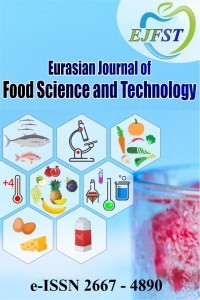Investigation of Antimicrobial and Photoprotective Activity of Hylocereus undatus Methanol Extracts
Investigation of Antimicrobial and Photoprotective Activity of Hylocereus undatus Methanol Extracts
White pitahaya, probiotic, cream formulation, antibacterial antifungal, photoprotective activity,
___
- Adeleye O.A., Babalola C.O., Femi-Oyewo M.N. & Balogun G.Y. 2019. Antimicrobial Activity and Stability of Andrographis paniculata Cream Containing Shea Butter, Nigerian Journal of Pharmaceutical Research, 15(1), 9-18.
- Asan-Ozusaglam M. & Celik I. 2023. White Pitahaya as a Natural Additive: Potential Usage in Cosmetic Industry, Foods and Raw Materials, 11(1), 57-63. https://doi.org/10.21603/2308-4057-2023-1-552
- Asan-Ozusaglam M. & Gunyakti A. 2019. Lactobacillus fermentum Strains from Human Breast Milk with Probiotic Properties and Cholesterol-lowering Effects, Food Science and Biotechnology, 28(2), 501–509. https://doi.org/10.1007/s10068-018-0494-y
- Asan-Ozusaglam M. & Gunyakti A. 2020. Characterization of Some Probiotic Properties of Lactobacillus gasseri MA-1 from Human Milk, Eskişehir Technical University Journal of Science and Technology C- Life Sciences and Biotechnology, 9(2), 211-218.
- Asan-Ozusaglam M. & Gunyakti A. 2022. Investigation of a New Lactobacillus delbrueckii Strain from Human Milk as a Probiotic Candidate, Journal of Food Safety and Food Quality-Archive fur Lebensmittelhygiene, 73(2), 45-74.
- Attar Ş.H., Gündeşli M.A., Urün I., Kafkas S., Kafkas N.E., Ercisli S., Ge C., Mlcek J. & Adamkova A. 2022. Nutritional Analysis of Red-Purple and White-Fleshed Pitaya (Hylocereus) Species, Molecules (Basel, Switzerland), 27(3), 808. https://doi.org/10.3390/molecules27030808
- Farjah M.H. & Farahpour M.R. 2020. Efficacy of Topical Platelet-rich Plasma and Chitosan Co-administration on Candida albicans-Infected Partial Thickness Burn Wound Healing, Burns, 46(8), 1889-1895.
- Imam S., Mahmood Z.A. & Azhar I.N. 2015. In Vitro Evaluation of Sun Protection Factor (SPF) of a Cream Formulation Prepared from Extracts of Musa accuminata (l.), Psidium gujava (l.) and Pyrus communis (L.), Asian Journal of Pharmaceutical and Clinical Research, 8(3), 234-237.
- Ishnava K.B. & Patel S.K. 2019. In-vitro Antioxidant and Antimicrobial Activity of Fruit Pulp and Peel of Hylocereus undatus (Haworth) Britton and Rose, Asian Journal of Ethnopharmacology and Medicinal Foods, 5(2), 30-34. ISSN: 2455-4812
- Kowalska-Krochmal B. & Dudek-Wicher R. 2021. The Minimum Inhibitory Concentration of Antibiotics: Methods, Interpretation, Clinical Relevance, Pathogens, 10(2), 165-186.
- Le Bellec F., Vaillant F. & Imbert E. 2006. Pitahaya (Hylocereus spp.): A New Fruit Crop, A Market with a Future, Fruits, 61(4), 237-250. https://doi.org/10.1051/fruits:2006021
- Lee J. Y., Kim Y., Kim J. I., Lee H. Y., Moon G. S. & Kang C. H. 2022. Improvements in Human Keratinocytes and Antimicrobial Effect Mediated by Cell-Free Supernatants Derived from Probiotics, Fermentation, 8(7), 332-338.
- Lohani A., Mishra A.K. & Verma A. 2019. Cosmeceutical Potential of Geranium and Calendula Essential Oil: Determination of Antioxidant Activity and In Vitro Sun Protection Factor, Journal of Cosmetic Dermatology, 18(2), 550-557.
- Luo H., Cai Y., Peng Z., Liu T. & Yang S. 2014. Chemical Composition and In Vitro Evaluation of The Cytotoxic and Antioxidant Activities of Supercritical Carbon Dioxide Extracts of Pitaya (Dragon Fruit) Peel, Chemistry Central Journal, 8(1), 1-7.
- Mahdi M.A., Mohammed M.T., Jassim A.M.N. & Mohammed A.I. 2018. Phytochemical Content and Antioxidant Activity of Hylocereus undatus and Study of Toxicity and The Ability of Wound Treatment, Plant Archives, 18(2), 2672-2680.
- Mansur J.S., Breder M.N.R., Mansur M.C.A. & Azulay R.D. 1986. Determinação Do Fator De Proteção Solar Por Espectrofotometria, An Bras Dermatol Rio De Janeiro, 61, 121-124.
- Nurmahani M.M., Osman A., Hamid A.A., Ghazali F.M. & Dek M.P. 2012. Antibacterial Property of Peel Extracts of Hylocereus polyrhizus and Hylocereus undatus, International Journal of Food Research, 19(1), 77-84.
- Ozkuyumcu C. 2009. Hacettepe Mikrobiyoloji Serisi 1 Klinik Bakteriyoloji El Kitabı. 1. baskı. Ankara, Turkey, Güneş Kitabevi, pp. 112-121.
- Perez G.R.M., Vargas S.R. & Ortiz H.Y.D. 2005. Wound Healing Properties of Hylocereus undatus on Diabetic Rats, Phytotherapy Research: PTR, 19(8), 665–668. https://doi.org/10.1002/ptr.1724
- Rohin M.A.K., Ali A.M. & Abdullah C. 2012. Antibacterial Activity of Flesh and Peel Methanol Fractions of Red Pitaya, White Pitaya, and Papaya on Selected Food Microorganisms, International Journal of Pharmacy and Pharmaceutical Sciences, 4(3), 185-190.
- Roudsari M.R., Karimi R., Sohrabvandi S. & Mortazavian A.M. 2015. Health Effects of Probiotics on The Skin, Critical Reviews in Food Science and Nutrition, 55(9), 1219–1240. https://doi.org/10.1080/10408398.2012.680078
- Schmidt W.P. 2004. Model of The Epidemic of Childhood Atopy, Medical Science Monitor: International Medical Journal of Experimental and Clinical Research, 10(2), HY5–HY9.
- Sushmitha H.S., Roy C.L., Gogoi D., Velagala R.D., Nagarathna A., Balasubramanian S. & Rajadurai M. 2018. Phytochemical and Pharmacological Studies on Hylocereus undatus Seeds: An In Vitro Approach, World Journal of Pharmacological Research, 7(14), 986-1006.
- Theingi P.P., Aye S.M. & Win H.H. 2019. Efficacy of Lactic Acid Bacteria from Edible Fruits Against Antibiotics and Pathogenic Bacteria, Journal of the Myanmar Academy of Arts and Science, Vol. XVII. No.4, 337-352.
- Turgut N. and Kaya O. 2015. Aydın İlinde Tüketime Sunulan Marullarda E. coli O157-H7 Varlığının Araştırılması, Avrupa Bilim ve Teknoloji Dergisi, 38, 507-513.
- Vijayakumar R, Abd Gani. S.S., Zaidan U.H., Halmi M.I.E., Karunakaran T. & Hamdan M.R. 2020. Exploring The Potential Use of Hylocereus polyrhizus Peels as a Source of Cosmeceutical Sunscreen Agent for Its Antioxidant and Photoprotective Properties, Evidence-Based Complementary and Alternative Medicine, 2020, 1-12. https://doi.org/10.1155/2020/7520736
- Yayın Aralığı: Yılda 2 Sayı
- Başlangıç: 2017
- Yayıncı: İlknur BAĞDATLI
Determination of Microbiological Quality of Fish Burgers Enriched with Orange Peel Extract
Investigation of Antimicrobial and Photoprotective Activity of Hylocereus undatus Methanol Extracts
Irem CELIK, Meltem ASAN-OZUSAGLAM
Olive Leaf: Antimicrobial and Antioxidant Properties, Food Applications, and Current Studies
Impact of Temperature on the Salty Taste Perception of Reduced Salt Ayran
